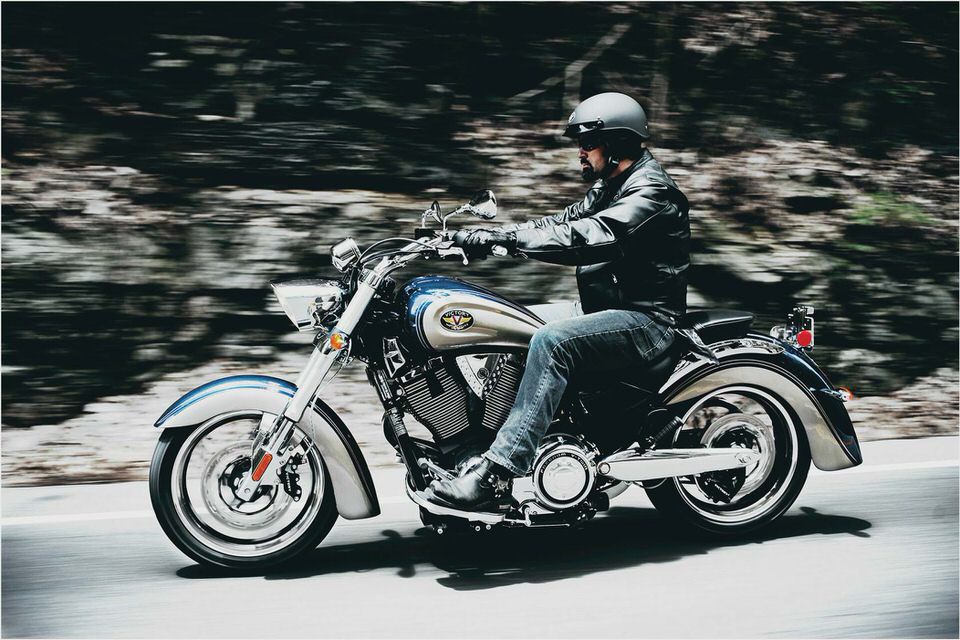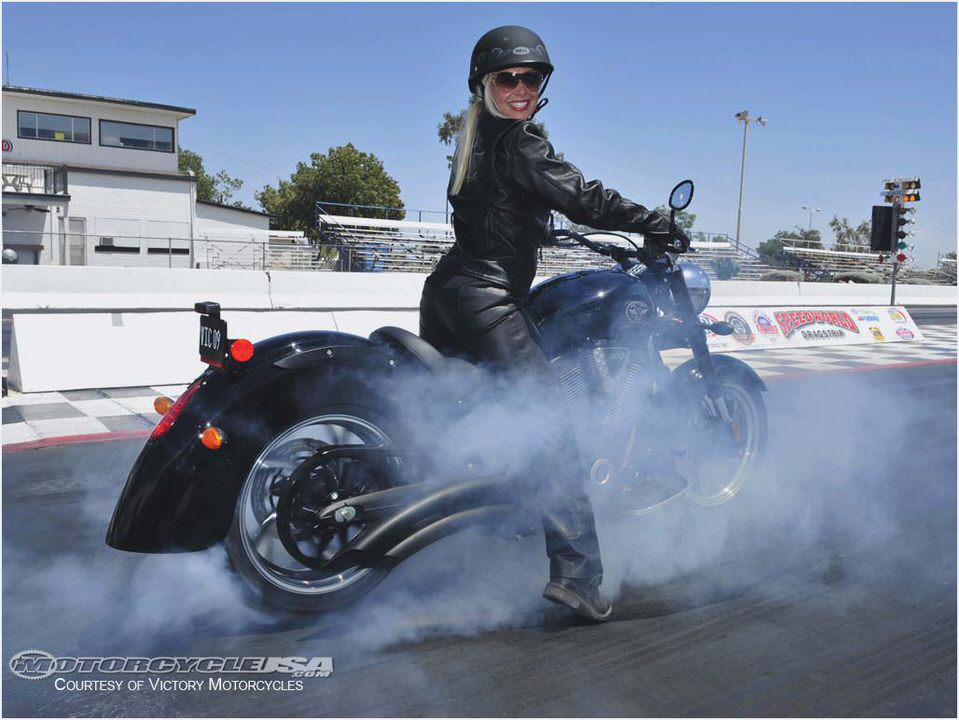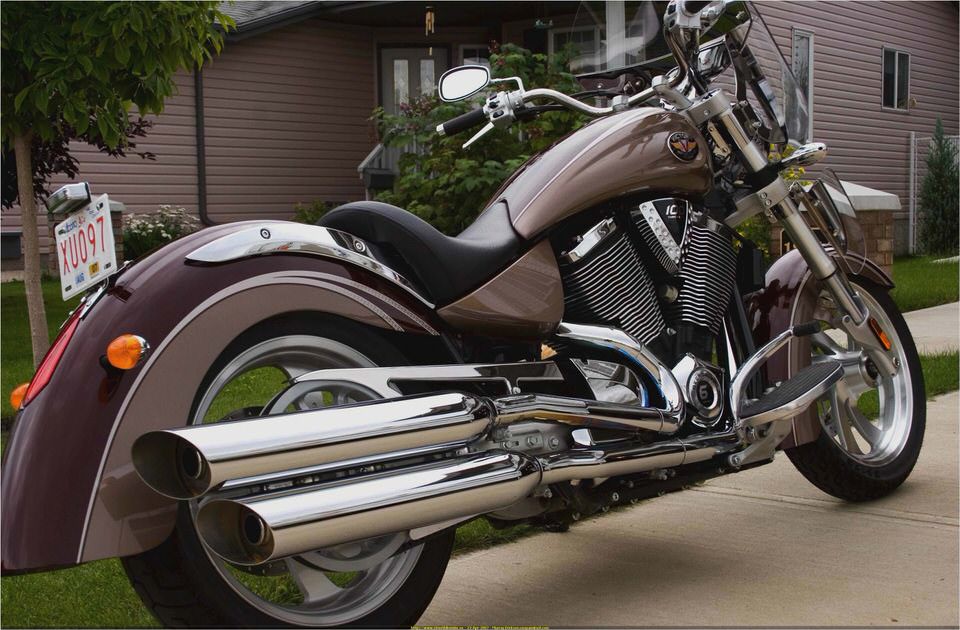
2008 Victory Kingpin 8-Ball Road Test
The Kingpin 8-Ball is a new model for 2008, and like its namesake from the pool hall, it is simple, direct, basic and commands attention.
Photo Credit: Kevin Wing
Bill Stermer
February 5, 2008
If you play pool, you know that the 8-ball is black, with a black numeral against a white circle. And you also know that—in the game of the same name—if you sink the 8-ball unintentionally, you’ve lost; sink it at the right time, however, and you win. It’s an important, dangerous orb, and if it gets in the way of your next shot we all understand what “being behind the 8-ball” means.
This ominous, critical, basic-in-black factor is why Victory chose to name two of its models after it, including the version we test here.
The Kingpin 8-Ball is a new model for 2008, and like its namesake from the pool hall, it is simple, direct, basic and commands attention. It features a blacked-out body, blacked-out engine with bright fins, black wheels and a blacked-out handlebar. In Victory parlance an 8-Ball is a base model with sinister, blacked-out styling, and to further show their baseness both models (the $13,999 Kingpin 8-Ball tested here, and the $13,599 Vegas 8-Ball) have only a solo seat and five-speed transmission; all other models feature the 6-speed box.
Like all other Victory models (except the new Vision with its 106-inch engine) the two 8-Balls utilize the company’s signature air/oil-cooled, 100-cubic-inch (1,634cc), 50-degree V-twin engine with single-overhead cams, four valves per cylinder and hydraulic lifters. For
Despite low-ball price, the 8-Ball’s suspension is first-rate for a cruiser.
2008 the 100-inch engine has been upgraded, whether it has been attached to the five- or six-cog transmission. Bore and stroke remain at 101 x 102mm, but compression ratio has been dropped from 9.8:1 on most previous models to 8.7:1 across the line. The revamped engine looks very similar to the previous version from the outside, but changes have been significant.
Externally, the airbox has been changed for more flow and style, and the oil cooler (that had previously been a rectangular unit hung like an afterthought across the frame downtubes) is now triangular and has been relocated down to where it fits between the lower frame tubes. It neatly tucks aside to clear the forward cylinder’s header pipe. Both internal and external oil routing are also new this year.
As with all other Victory models, the Kingpin 8-Ball is equipped with belt final drive.
Inside is where the real changes have occurred. The new closed-loop fuel-injection system consists of new oxygen sensors, Engine Control Module (ECM) and 45mm throttle-body injectors to make the engine run cleaner, quieter and more efficiently. To reduce noise, vibration and harshness the 100-inch Victory engines get a slew of new components including the cams, pistons, rods, crankshaft, balance shaft, crankcases and engine covers.
And it all works well together.
Seating position is spread out and comfortable, and the optional Victory windscreen is welcome.
Approach the all-black Kingpin and nothing about it announces that this is a low-end model; nothing screams “Cheapo! Bargain! Kmart Blue Light Special!” Not only is the 8-Ball a hunk—low and black with those fully valanced fenders—but its stretched-look flangeless steel tank, clear-lens headlight with faceted reflector and teardrop-style taillight give it the look of a full custom.
Also note how the tank is notched to accommodate the pointed solo seat. Anyway you look at it, the Kingpin 8-Ball has that lean, menacing demeanor of a pool hustler from a gritty movie.
While the Victory Hammer and Jackpot models carry super-wide 250-series rear tires that are great for show but will make a bike harder to turn, the Kingpin and Vegas lines are more rider’s bikes as all models within them carry a 180-series rear tire. The Kingpin is a big, spread-out motorcycle, which places the feet forward on floorboards with the elbows bent because of the pull-back handlebar. At 26.5 inches off the asphalt the seat is low, and the key is centered in the triangular EFI cover on the left side under the tank; an identical cover has been added on the right side.
Instrumentation is the height of simplicity and elegance.
The bike starts simply and easily (doesn’t anything have a choke or fast-idle control anymore?), and clutch pull is moderate. It moves out smartly with a minimum of clutch slippage, and the heel-and-toe shifter works with easy crispness. First gear has been given a lower ratio this year for enhanced starting and acceleration.
The exhaust has a good, sharp note, with a bit of a bark to it; it’s one that we journalists call “authoritative.” Vibration is present, though only in its most pleasant guise of a gentle throbbing through the seat and grips as the revs rise, which is just where you want them.
With its size and the heft of a 65.6-inch wheelbase and 692-pound wet weight the 8-Ball certainly fulfills the “real steel” concept. Its generous specs include 32.8 degrees of rake and 5.4 inches of trail; steering is solid and neutral, though far from quick. Cornering clearance, the bane of most cruisers, is adequate on the 8-Ball, but of course we always want more before its folding floorboards begin to drag.
With the 8-Ball’s power, relative lightness and solid feel you’ll want to explore its cornering limits on its Dunlop tires.
In its wake, the Kingpin 8-Ball leaves an authoritative exhaust note with a pleasant bark.
When cruisers first appeared more than 25 years ago, they were notorious for having low-buck suspensions delivering rocky rides. In these modern times this hustler’s male-slider fork is very well damped and controlled, and at the rear is a single shock adjustable for spring preload. It is likewise well controlled while delivering a relatively comfortable ride for its short travel.
Braking is provided by a single disc at each end gripped by a four-piston (front) and two-piston (rear) caliper. Braking is likewise powerful and easily modulated. Though small in size, the seat is very well padded and shaped, and proved much more comfortable than expected.
At highway speeds I experienced some noticeable wind against my torso and legs, the breeze flapping my jeans and trying to push my feet off the footboards. The pull-back handlebar also hangs the rider out there like a spinnaker. To alleviate the upper-body pressure we requested Victory’s Lock and Ride Windshield, and they sent us their smaller version.
Its chromed brackets went on easily despite some lack of clarity in the directions; in the case of the 8-Ball a blacked-out set would have been more appropriate. With the windscreen set in place on rubber grommets, the key provided deploys a pin on each side through the bracket to lock the ’screen in place. The same key retracts the pins and allowed for the ’screen’s easy removal.
While it relieved the pressure to the torso at the expense of some minor head buffeting, the ’screen did not relieve wind pressure against the legs.
The single front disc, with its four-piston caliper, offers easily modulated stopping power.
Our 8-Ball has no tachometer, but the Borla Performance dynamometer confirmed that by 2,500 rpm it is already generating 86 lb-ft of torque, and it peaks at 70 horsepower at 4,800 rpm. Both show how the Victory engine’s slightly higher displacement and SOHC, four-valve cylinder-head design help give it a stock performance edge over the American competition.
The tank holds 4.5 gallons of fuel, and a low-fuel warning light illuminates on the dash when only about a gallon is left. Through our testing period the 8-Ball delivered a decent 42.3 miles in return for each gallon of gas.
Obviously, the Kingpin 8-Ball is a spare, emotional bike that doesn’t offer much in the way of practicalities, though many are available as options. Not only does the lack of a rear seat preclude carrying a passenger, it also means you won’t be able to attach a seat bag or camping gear—which essentially relegates it to “bar-hopper” status. We ordered up the small Victory magnetic tankbag that will hold just a dieter’s lunch or perhaps a spare set of gloves.
Though outward appearance has changed little, the engine has been updated for 2008.
Any nits to pick are minor. The bike lacks a tachometer, but it can be reasoned that that’s in keeping with its character of sparseness while helping keep the price relatively low. The 8-Ball logo on each fender is a peel-off decal, which seems out of place on such an otherwise quality machine.
Victory explains that the decal is designed to be easily peeled off to leave an even stealthier machine, but that seems a strange thing to do with a bike’s model name. It does reflect the maker’s second-most important goal for the 8-Balls besides being Victory’s entry-level-priced machines—to give mild-to-wild customizers a ready-made platform to build upon.
For its $13,999 MSRP the 8-Ball delivers a lot of performance and presence for a reasonable amount of cash. This hustler offers not only incredible style for the price, but is also notably updated from previous models. And for those who like their machinery domestic, please note that Victory motorcycles are built in the Great White North up in Medina, Minnesota.
This new model not only hustles down the road, but riding one translates to a situation in which being behind the 8-Ball is very fortunate indeed.




- 2007 Victory Hammer
- Design Analysis: Victory Core concept RideApart
- 2010 Victory Hammer 8 Ball Troubleshooting, Repair, Maintenance & Tune…
- 2013 Victory Cory Ness Victory Cross Country Tour Review
- Victory Hammer Saddlebags. Genuine Range of Hard and Leather Bags
